Innovative Revenue Management and Route Optimization by Azul
VerifiedAdded on 2020/04/21
|33
|6260
|537
AI Summary
Azul Brazilian Airlines has demonstrated exemplary strategic planning in a competitive airline industry marked by deregulation challenges. By forming long-term partnerships with entities like United Airlines and adopting advanced technologies from Sabre, Azul expanded its market presence across the USA, Brazil, and globally. This collaboration allowed for enhanced distribution capabilities and increased sales effectiveness. Further, amidst a fragmented market landscape following Brazilian deregulation, Azul focused on innovative revenue management techniques and route optimization to maintain robust financial health, reflected in record profits and significant load factors. Additionally, strategic alliances have played a crucial role not just in expanding operational reach but also in building lasting customer loyalty through improved service offerings and competitive fares. This case study highlights the critical elements that contribute to sustained success in the airline sector.

Running head: STRATEGIC MANAGEMENT
Strategic Management of Airline Industry: Azul Brazilian Airlines
Name of the Student:
Name of the University:
Strategic Management of Airline Industry: Azul Brazilian Airlines
Name of the Student:
Name of the University:
Paraphrase This Document
Need a fresh take? Get an instant paraphrase of this document with our AI Paraphraser
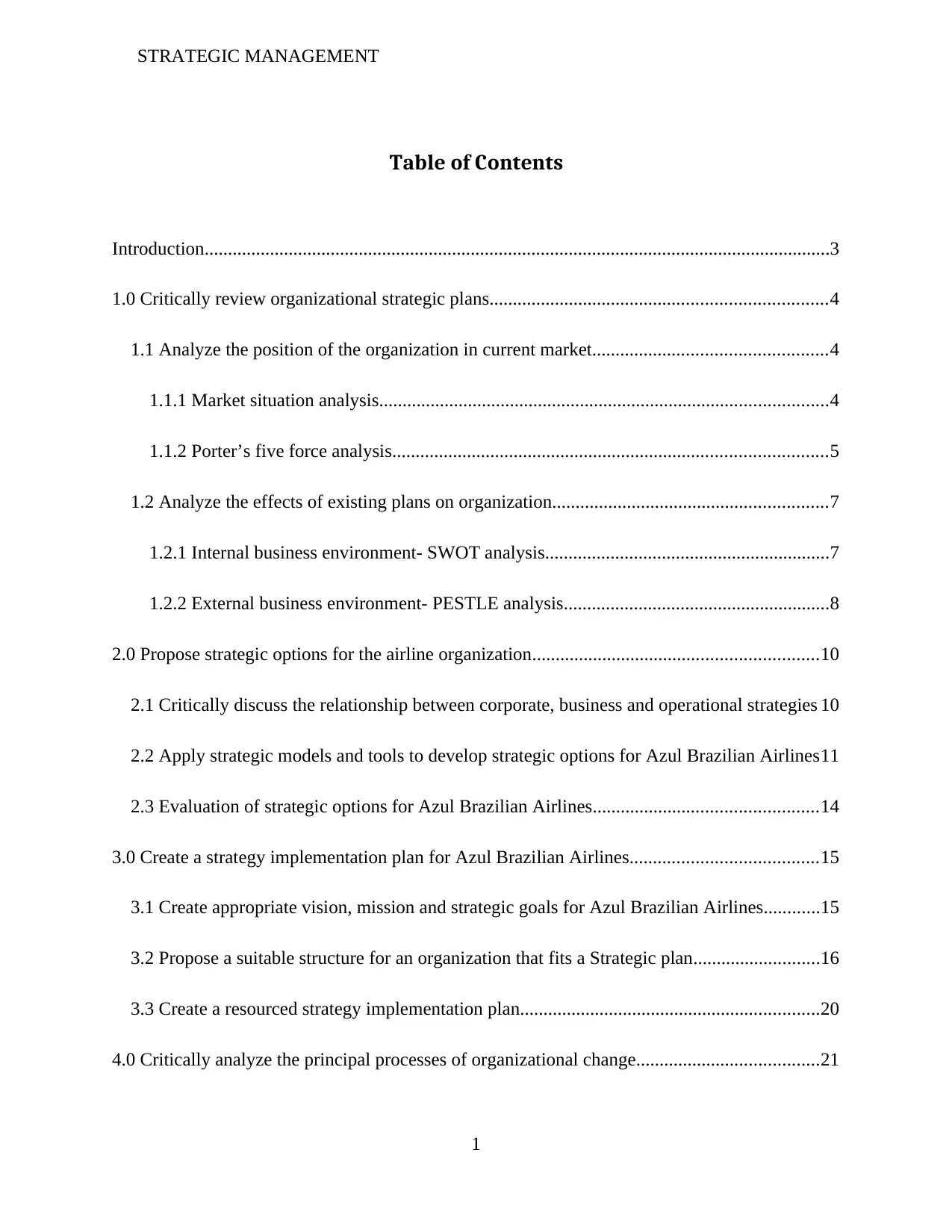
STRATEGIC MANAGEMENT
Table of Contents
Introduction......................................................................................................................................3
1.0 Critically review organizational strategic plans........................................................................4
1.1 Analyze the position of the organization in current market..................................................4
1.1.1 Market situation analysis................................................................................................4
1.1.2 Porter’s five force analysis.............................................................................................5
1.2 Analyze the effects of existing plans on organization...........................................................7
1.2.1 Internal business environment- SWOT analysis.............................................................7
1.2.2 External business environment- PESTLE analysis.........................................................8
2.0 Propose strategic options for the airline organization.............................................................10
2.1 Critically discuss the relationship between corporate, business and operational strategies 10
2.2 Apply strategic models and tools to develop strategic options for Azul Brazilian Airlines11
2.3 Evaluation of strategic options for Azul Brazilian Airlines................................................14
3.0 Create a strategy implementation plan for Azul Brazilian Airlines........................................15
3.1 Create appropriate vision, mission and strategic goals for Azul Brazilian Airlines............15
3.2 Propose a suitable structure for an organization that fits a Strategic plan...........................16
3.3 Create a resourced strategy implementation plan................................................................20
4.0 Critically analyze the principal processes of organizational change.......................................21
1
Table of Contents
Introduction......................................................................................................................................3
1.0 Critically review organizational strategic plans........................................................................4
1.1 Analyze the position of the organization in current market..................................................4
1.1.1 Market situation analysis................................................................................................4
1.1.2 Porter’s five force analysis.............................................................................................5
1.2 Analyze the effects of existing plans on organization...........................................................7
1.2.1 Internal business environment- SWOT analysis.............................................................7
1.2.2 External business environment- PESTLE analysis.........................................................8
2.0 Propose strategic options for the airline organization.............................................................10
2.1 Critically discuss the relationship between corporate, business and operational strategies 10
2.2 Apply strategic models and tools to develop strategic options for Azul Brazilian Airlines11
2.3 Evaluation of strategic options for Azul Brazilian Airlines................................................14
3.0 Create a strategy implementation plan for Azul Brazilian Airlines........................................15
3.1 Create appropriate vision, mission and strategic goals for Azul Brazilian Airlines............15
3.2 Propose a suitable structure for an organization that fits a Strategic plan...........................16
3.3 Create a resourced strategy implementation plan................................................................20
4.0 Critically analyze the principal processes of organizational change.......................................21
1
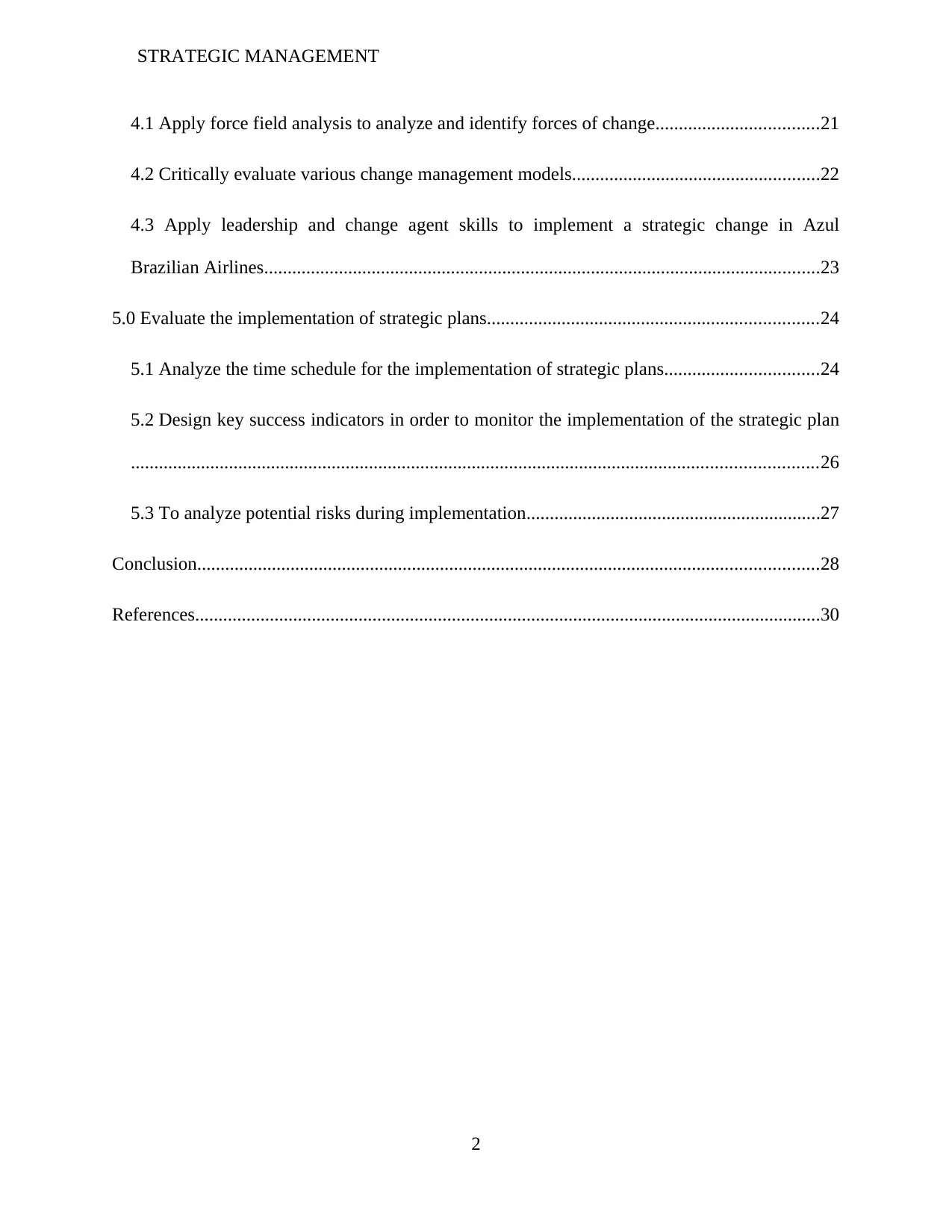
STRATEGIC MANAGEMENT
4.1 Apply force field analysis to analyze and identify forces of change...................................21
4.2 Critically evaluate various change management models.....................................................22
4.3 Apply leadership and change agent skills to implement a strategic change in Azul
Brazilian Airlines.......................................................................................................................23
5.0 Evaluate the implementation of strategic plans.......................................................................24
5.1 Analyze the time schedule for the implementation of strategic plans.................................24
5.2 Design key success indicators in order to monitor the implementation of the strategic plan
...................................................................................................................................................26
5.3 To analyze potential risks during implementation...............................................................27
Conclusion.....................................................................................................................................28
References......................................................................................................................................30
2
4.1 Apply force field analysis to analyze and identify forces of change...................................21
4.2 Critically evaluate various change management models.....................................................22
4.3 Apply leadership and change agent skills to implement a strategic change in Azul
Brazilian Airlines.......................................................................................................................23
5.0 Evaluate the implementation of strategic plans.......................................................................24
5.1 Analyze the time schedule for the implementation of strategic plans.................................24
5.2 Design key success indicators in order to monitor the implementation of the strategic plan
...................................................................................................................................................26
5.3 To analyze potential risks during implementation...............................................................27
Conclusion.....................................................................................................................................28
References......................................................................................................................................30
2
⊘ This is a preview!⊘
Do you want full access?
Subscribe today to unlock all pages.

Trusted by 1+ million students worldwide

STRATEGIC MANAGEMENT
Introduction
In today’s world, low cost carrier airlines become a trend, therefore the airline industry
applied of strategies to grow into the market. Airline industry is chosen for this particular report
to analyze the strategic plan of the organization, Azul Brazilian Airlines. It provides with
passenger as well as cargo air transport services within Brazil1. The airline organization provides
of air transportation services with connecting cities in Brazil. The company is founded in the
year 2008 with fleet size of 144. Azul Brazilian Airlines is the third largest airline within the
country2. The airline industry utilizes of technology in order to reduce the cost and propose of
better service with superior expediency to passengers.
The report analyses the organizational strategic plans, strategic options, creates an
implementation plan for the organization, analyses the principle processes of the organizational
changes and implementation of the strategic plans. Both internal in addition to external business
environment are also analyzed for implementation of the strategic plans of the airline industry.
This particular report also analyzed the internal and external business environment using
strategic models and tools. Different change management models are also analyzed to implement
of changes into the organization using Koter’s 8 step change model.
1 Sabre.com, "Azul Brazilian Airlines implements Sabre’s distribution technology to boost sales in the USA, Brazil
and global markets « Sabre", in Sabre.com, , 2015, <https://www.sabre.com/insights/releases/azul-brazilian-airlines-
implements-sabres-distribution-technology-to-boost-sales-in-the-usa-brazil-and-global-markets/> [accessed 3
November 2017].
2 Worldairlinenews.com, "Azul Brazilian Airlines | World Airline News", in Worldairlinenews.com, , 2015,
<https://worldairlinenews.com/tag/azul-brazilian-airlines/> [accessed 3 November 2017].
3
Introduction
In today’s world, low cost carrier airlines become a trend, therefore the airline industry
applied of strategies to grow into the market. Airline industry is chosen for this particular report
to analyze the strategic plan of the organization, Azul Brazilian Airlines. It provides with
passenger as well as cargo air transport services within Brazil1. The airline organization provides
of air transportation services with connecting cities in Brazil. The company is founded in the
year 2008 with fleet size of 144. Azul Brazilian Airlines is the third largest airline within the
country2. The airline industry utilizes of technology in order to reduce the cost and propose of
better service with superior expediency to passengers.
The report analyses the organizational strategic plans, strategic options, creates an
implementation plan for the organization, analyses the principle processes of the organizational
changes and implementation of the strategic plans. Both internal in addition to external business
environment are also analyzed for implementation of the strategic plans of the airline industry.
This particular report also analyzed the internal and external business environment using
strategic models and tools. Different change management models are also analyzed to implement
of changes into the organization using Koter’s 8 step change model.
1 Sabre.com, "Azul Brazilian Airlines implements Sabre’s distribution technology to boost sales in the USA, Brazil
and global markets « Sabre", in Sabre.com, , 2015, <https://www.sabre.com/insights/releases/azul-brazilian-airlines-
implements-sabres-distribution-technology-to-boost-sales-in-the-usa-brazil-and-global-markets/> [accessed 3
November 2017].
2 Worldairlinenews.com, "Azul Brazilian Airlines | World Airline News", in Worldairlinenews.com, , 2015,
<https://worldairlinenews.com/tag/azul-brazilian-airlines/> [accessed 3 November 2017].
3
Paraphrase This Document
Need a fresh take? Get an instant paraphrase of this document with our AI Paraphraser

STRATEGIC MANAGEMENT
1.0 Critically review organizational strategic plans
1.1 Analyze the position of the organization in current market
1.1.1 Market situation analysis
Azul Brazilian Airlines is the third largest airline within Brazil. With the purchase of “63
airbus group NV (AIR) A320neo jets”, Azul is being poised in order to operate their largest
planes on the domestic routes. The airline organization is going to offer 3000 more seats than
other foremost airlines. Currently, the airline organization has largest airline network in terms of
cities served, with service more than 100 destinations as well as 792 daily flights3.
Items 2012 2013 2014 2015 2016
Passengers
transported
12 million 20 million 21 million 22 million 24 million
Aircraft into
services
118 133 138 138 139
Destinations 100 103 105 106 107
Market share 15% 17% 17% 18% 19%
Table 1: Key drivers of continuous growth of Azul Brazilian Airlines
(Source: 4)
3 Voeazul.com.br, "About Azul", in Voeazul.com.br, , 2015, <https://www.voeazul.com.br/en/about-azul/about-
azul> [accessed 3 November 2017].
4 United - Newsroom, "United Airlines and Azul Brazilian Airlines Form Long-Term Strategic Partnership",
in United - Newsroom, , 2015, <http://newsroom.united.com/2015-06-26-United-Airlines-and-Azul-Brazilian-
Airlines-Form-Long-Term-Strategic-Partnership> [accessed 3 November 2017].
4
1.0 Critically review organizational strategic plans
1.1 Analyze the position of the organization in current market
1.1.1 Market situation analysis
Azul Brazilian Airlines is the third largest airline within Brazil. With the purchase of “63
airbus group NV (AIR) A320neo jets”, Azul is being poised in order to operate their largest
planes on the domestic routes. The airline organization is going to offer 3000 more seats than
other foremost airlines. Currently, the airline organization has largest airline network in terms of
cities served, with service more than 100 destinations as well as 792 daily flights3.
Items 2012 2013 2014 2015 2016
Passengers
transported
12 million 20 million 21 million 22 million 24 million
Aircraft into
services
118 133 138 138 139
Destinations 100 103 105 106 107
Market share 15% 17% 17% 18% 19%
Table 1: Key drivers of continuous growth of Azul Brazilian Airlines
(Source: 4)
3 Voeazul.com.br, "About Azul", in Voeazul.com.br, , 2015, <https://www.voeazul.com.br/en/about-azul/about-
azul> [accessed 3 November 2017].
4 United - Newsroom, "United Airlines and Azul Brazilian Airlines Form Long-Term Strategic Partnership",
in United - Newsroom, , 2015, <http://newsroom.united.com/2015-06-26-United-Airlines-and-Azul-Brazilian-
Airlines-Form-Long-Term-Strategic-Partnership> [accessed 3 November 2017].
4
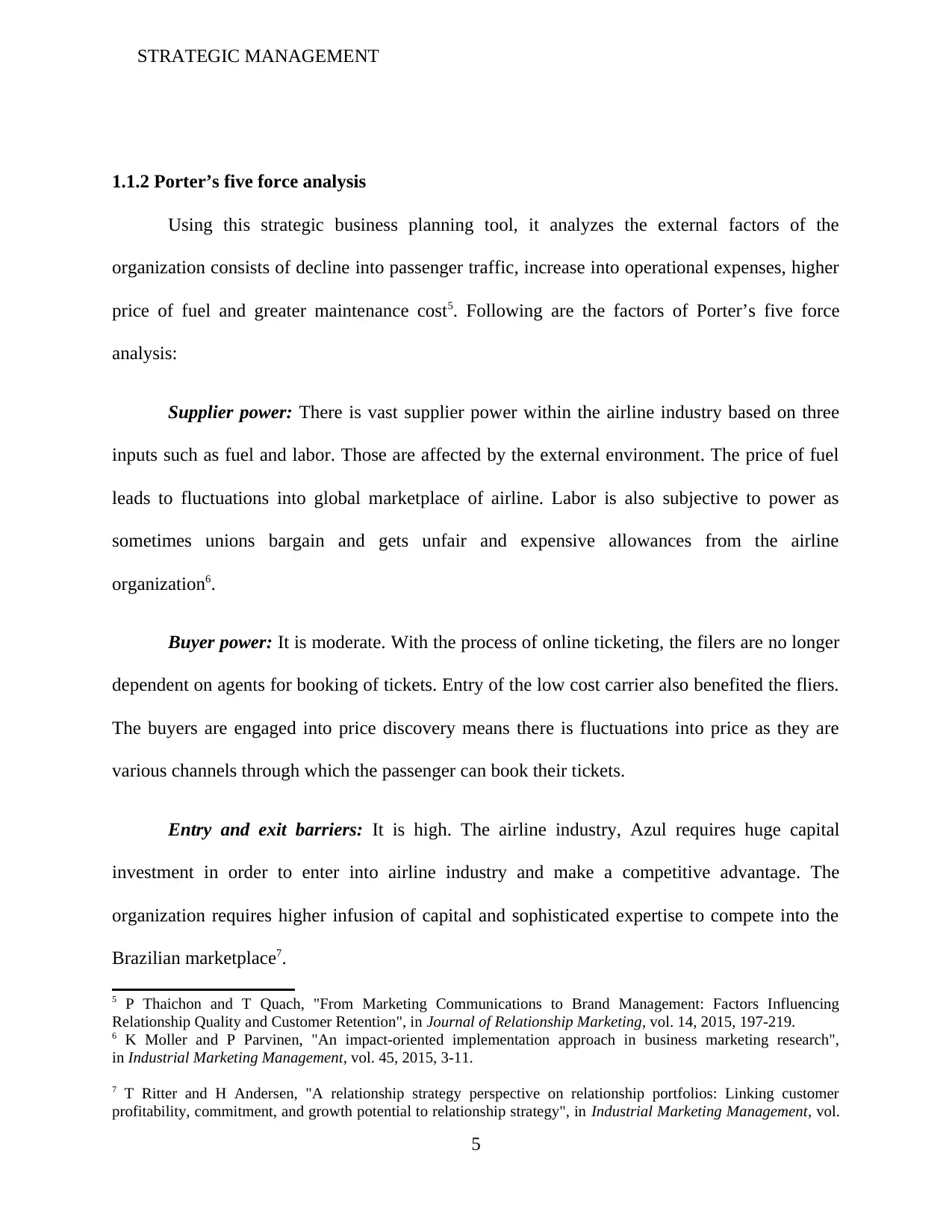
STRATEGIC MANAGEMENT
1.1.2 Porter’s five force analysis
Using this strategic business planning tool, it analyzes the external factors of the
organization consists of decline into passenger traffic, increase into operational expenses, higher
price of fuel and greater maintenance cost5. Following are the factors of Porter’s five force
analysis:
Supplier power: There is vast supplier power within the airline industry based on three
inputs such as fuel and labor. Those are affected by the external environment. The price of fuel
leads to fluctuations into global marketplace of airline. Labor is also subjective to power as
sometimes unions bargain and gets unfair and expensive allowances from the airline
organization6.
Buyer power: It is moderate. With the process of online ticketing, the filers are no longer
dependent on agents for booking of tickets. Entry of the low cost carrier also benefited the fliers.
The buyers are engaged into price discovery means there is fluctuations into price as they are
various channels through which the passenger can book their tickets.
Entry and exit barriers: It is high. The airline industry, Azul requires huge capital
investment in order to enter into airline industry and make a competitive advantage. The
organization requires higher infusion of capital and sophisticated expertise to compete into the
Brazilian marketplace7.
5 P Thaichon and T Quach, "From Marketing Communications to Brand Management: Factors Influencing
Relationship Quality and Customer Retention", in Journal of Relationship Marketing, vol. 14, 2015, 197-219.
6 K Moller and P Parvinen, "An impact-oriented implementation approach in business marketing research",
in Industrial Marketing Management, vol. 45, 2015, 3-11.
7 T Ritter and H Andersen, "A relationship strategy perspective on relationship portfolios: Linking customer
profitability, commitment, and growth potential to relationship strategy", in Industrial Marketing Management, vol.
5
1.1.2 Porter’s five force analysis
Using this strategic business planning tool, it analyzes the external factors of the
organization consists of decline into passenger traffic, increase into operational expenses, higher
price of fuel and greater maintenance cost5. Following are the factors of Porter’s five force
analysis:
Supplier power: There is vast supplier power within the airline industry based on three
inputs such as fuel and labor. Those are affected by the external environment. The price of fuel
leads to fluctuations into global marketplace of airline. Labor is also subjective to power as
sometimes unions bargain and gets unfair and expensive allowances from the airline
organization6.
Buyer power: It is moderate. With the process of online ticketing, the filers are no longer
dependent on agents for booking of tickets. Entry of the low cost carrier also benefited the fliers.
The buyers are engaged into price discovery means there is fluctuations into price as they are
various channels through which the passenger can book their tickets.
Entry and exit barriers: It is high. The airline industry, Azul requires huge capital
investment in order to enter into airline industry and make a competitive advantage. The
organization requires higher infusion of capital and sophisticated expertise to compete into the
Brazilian marketplace7.
5 P Thaichon and T Quach, "From Marketing Communications to Brand Management: Factors Influencing
Relationship Quality and Customer Retention", in Journal of Relationship Marketing, vol. 14, 2015, 197-219.
6 K Moller and P Parvinen, "An impact-oriented implementation approach in business marketing research",
in Industrial Marketing Management, vol. 45, 2015, 3-11.
7 T Ritter and H Andersen, "A relationship strategy perspective on relationship portfolios: Linking customer
profitability, commitment, and growth potential to relationship strategy", in Industrial Marketing Management, vol.
5
⊘ This is a preview!⊘
Do you want full access?
Subscribe today to unlock all pages.

Trusted by 1+ million students worldwide
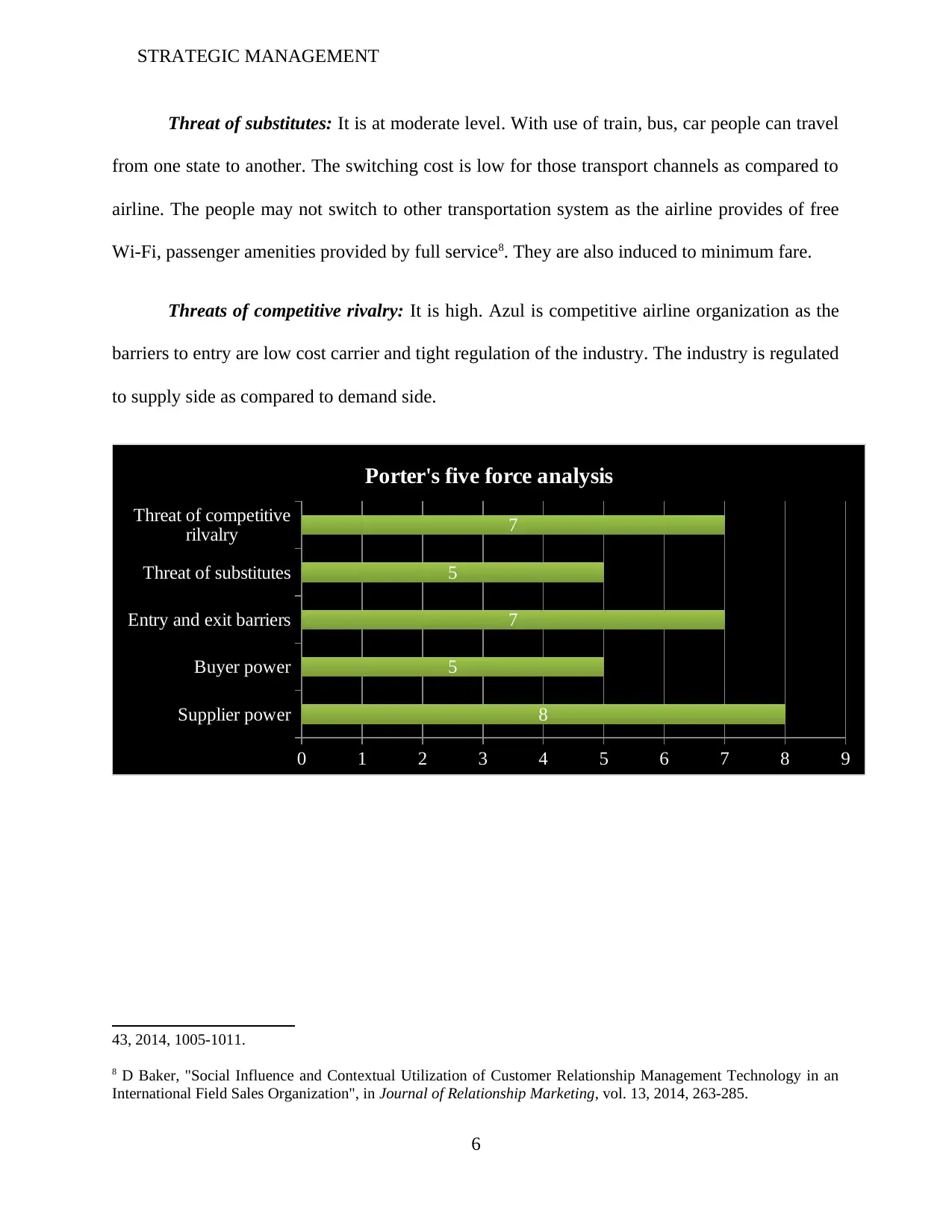
STRATEGIC MANAGEMENT
Threat of substitutes: It is at moderate level. With use of train, bus, car people can travel
from one state to another. The switching cost is low for those transport channels as compared to
airline. The people may not switch to other transportation system as the airline provides of free
Wi-Fi, passenger amenities provided by full service8. They are also induced to minimum fare.
Threats of competitive rivalry: It is high. Azul is competitive airline organization as the
barriers to entry are low cost carrier and tight regulation of the industry. The industry is regulated
to supply side as compared to demand side.
43, 2014, 1005-1011.
8 D Baker, "Social Influence and Contextual Utilization of Customer Relationship Management Technology in an
International Field Sales Organization", in Journal of Relationship Marketing, vol. 13, 2014, 263-285.
6
Supplier power
Buyer power
Entry and exit barriers
Threat of substitutes
Threat of competitive
rilvalry
0 1 2 3 4 5 6 7 8 9
8
5
7
5
7
Porter's five force analysis
Threat of substitutes: It is at moderate level. With use of train, bus, car people can travel
from one state to another. The switching cost is low for those transport channels as compared to
airline. The people may not switch to other transportation system as the airline provides of free
Wi-Fi, passenger amenities provided by full service8. They are also induced to minimum fare.
Threats of competitive rivalry: It is high. Azul is competitive airline organization as the
barriers to entry are low cost carrier and tight regulation of the industry. The industry is regulated
to supply side as compared to demand side.
43, 2014, 1005-1011.
8 D Baker, "Social Influence and Contextual Utilization of Customer Relationship Management Technology in an
International Field Sales Organization", in Journal of Relationship Marketing, vol. 13, 2014, 263-285.
6
Supplier power
Buyer power
Entry and exit barriers
Threat of substitutes
Threat of competitive
rilvalry
0 1 2 3 4 5 6 7 8 9
8
5
7
5
7
Porter's five force analysis
Paraphrase This Document
Need a fresh take? Get an instant paraphrase of this document with our AI Paraphraser
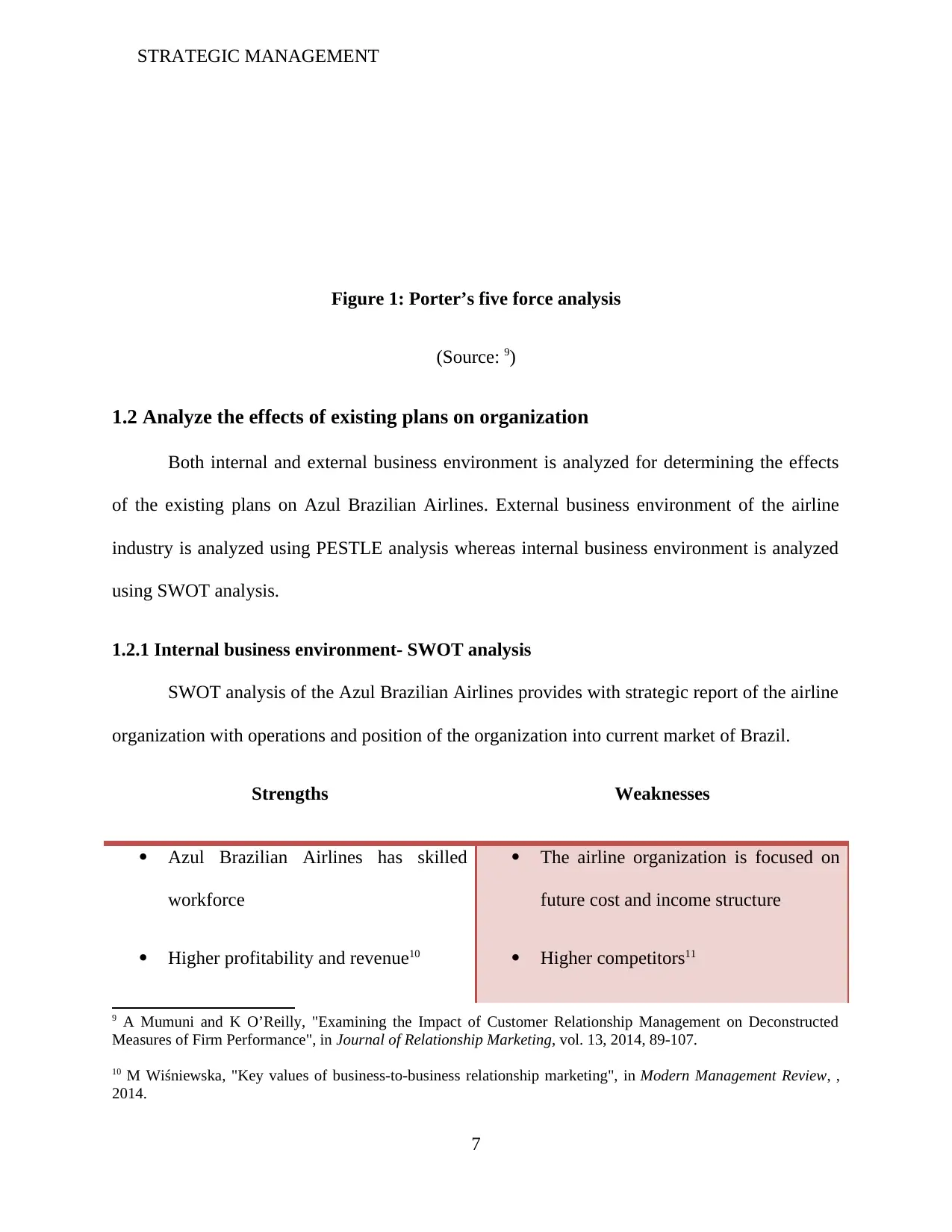
STRATEGIC MANAGEMENT
Figure 1: Porter’s five force analysis
(Source: 9)
1.2 Analyze the effects of existing plans on organization
Both internal and external business environment is analyzed for determining the effects
of the existing plans on Azul Brazilian Airlines. External business environment of the airline
industry is analyzed using PESTLE analysis whereas internal business environment is analyzed
using SWOT analysis.
1.2.1 Internal business environment- SWOT analysis
SWOT analysis of the Azul Brazilian Airlines provides with strategic report of the airline
organization with operations and position of the organization into current market of Brazil.
Strengths Weaknesses
Azul Brazilian Airlines has skilled
workforce
Higher profitability and revenue10
The airline organization is focused on
future cost and income structure
Higher competitors11
9 A Mumuni and K O’Reilly, "Examining the Impact of Customer Relationship Management on Deconstructed
Measures of Firm Performance", in Journal of Relationship Marketing, vol. 13, 2014, 89-107.
10 M Wiśniewska, "Key values of business-to-business relationship marketing", in Modern Management Review, ,
2014.
7
Figure 1: Porter’s five force analysis
(Source: 9)
1.2 Analyze the effects of existing plans on organization
Both internal and external business environment is analyzed for determining the effects
of the existing plans on Azul Brazilian Airlines. External business environment of the airline
industry is analyzed using PESTLE analysis whereas internal business environment is analyzed
using SWOT analysis.
1.2.1 Internal business environment- SWOT analysis
SWOT analysis of the Azul Brazilian Airlines provides with strategic report of the airline
organization with operations and position of the organization into current market of Brazil.
Strengths Weaknesses
Azul Brazilian Airlines has skilled
workforce
Higher profitability and revenue10
The airline organization is focused on
future cost and income structure
Higher competitors11
9 A Mumuni and K O’Reilly, "Examining the Impact of Customer Relationship Management on Deconstructed
Measures of Firm Performance", in Journal of Relationship Marketing, vol. 13, 2014, 89-107.
10 M Wiśniewska, "Key values of business-to-business relationship marketing", in Modern Management Review, ,
2014.
7
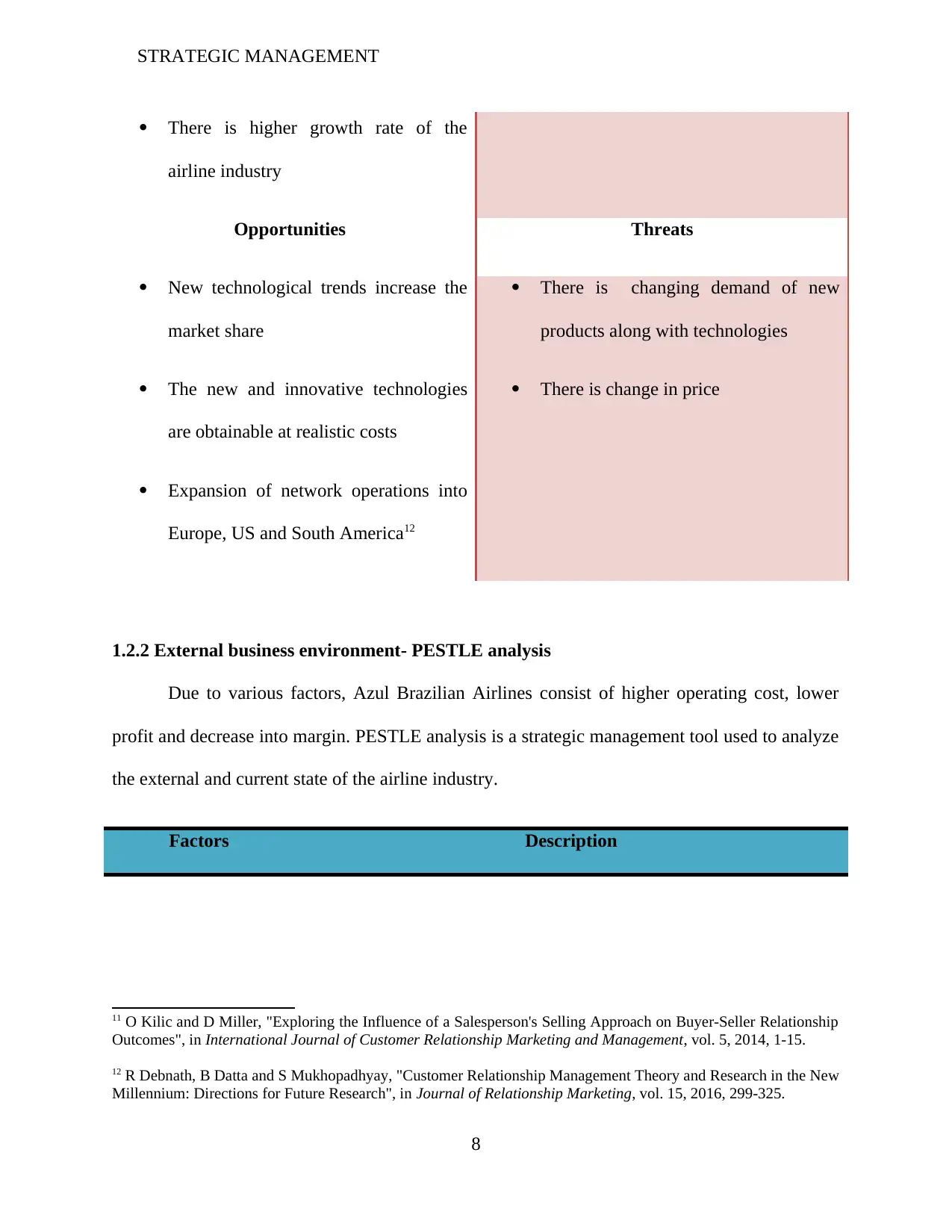
STRATEGIC MANAGEMENT
There is higher growth rate of the
airline industry
Opportunities Threats
New technological trends increase the
market share
The new and innovative technologies
are obtainable at realistic costs
Expansion of network operations into
Europe, US and South America12
There is changing demand of new
products along with technologies
There is change in price
1.2.2 External business environment- PESTLE analysis
Due to various factors, Azul Brazilian Airlines consist of higher operating cost, lower
profit and decrease into margin. PESTLE analysis is a strategic management tool used to analyze
the external and current state of the airline industry.
Factors Description
11 O Kilic and D Miller, "Exploring the Influence of a Salesperson's Selling Approach on Buyer-Seller Relationship
Outcomes", in International Journal of Customer Relationship Marketing and Management, vol. 5, 2014, 1-15.
12 R Debnath, B Datta and S Mukhopadhyay, "Customer Relationship Management Theory and Research in the New
Millennium: Directions for Future Research", in Journal of Relationship Marketing, vol. 15, 2016, 299-325.
8
There is higher growth rate of the
airline industry
Opportunities Threats
New technological trends increase the
market share
The new and innovative technologies
are obtainable at realistic costs
Expansion of network operations into
Europe, US and South America12
There is changing demand of new
products along with technologies
There is change in price
1.2.2 External business environment- PESTLE analysis
Due to various factors, Azul Brazilian Airlines consist of higher operating cost, lower
profit and decrease into margin. PESTLE analysis is a strategic management tool used to analyze
the external and current state of the airline industry.
Factors Description
11 O Kilic and D Miller, "Exploring the Influence of a Salesperson's Selling Approach on Buyer-Seller Relationship
Outcomes", in International Journal of Customer Relationship Marketing and Management, vol. 5, 2014, 1-15.
12 R Debnath, B Datta and S Mukhopadhyay, "Customer Relationship Management Theory and Research in the New
Millennium: Directions for Future Research", in Journal of Relationship Marketing, vol. 15, 2016, 299-325.
8
⊘ This is a preview!⊘
Do you want full access?
Subscribe today to unlock all pages.

Trusted by 1+ million students worldwide

STRATEGIC MANAGEMENT
Political factor The political environment of the airline industry is highly regulated and
it favored the passengers over the airlines. Azul Brazilian Airlines
operated into such an environment where the safety of passengers is at
higher priority13. Brazil ranked 72nd out of 180 countries in case of
corruption.
Economic factor The potential growth of Brazil is high. Prolonged recession,
fluctuations into the price of oil and global slowdown are the factors
which affect the growth of airline industry14.
Social factor The passengers are become more demanding; therefore their demands
are changing day-by-day. There is change into profile of passengers
where there being more economical minded.
Technological factor The airline industry adopted of latest technology to compete into the
market. It will result into lower the consumption of fuel, cost of airline
operations with improved into efficiency15.
Legal factor Lawsuits against the airline industry are gone up. It is due to intolerant
of the delays and safety issues.
13 S Forkmann et al., "Supplier relationship management capability: a qualification and extension", in Industrial
Marketing Management, vol. 57, 2016, 185-200.
15 T Jung, E Ineson and E Green, "Online social networking: Relationship marketing in UK hotels", in Journal of
Marketing Management, vol. 29, 2013, 393-420.
14 S Kladou and E Mavragani, "Assessing destination image: An online marketing approach and the case of
TripAdvisor", in Journal of Destination Marketing & Management, vol. 4, 2015, 187-193.
9
Political factor The political environment of the airline industry is highly regulated and
it favored the passengers over the airlines. Azul Brazilian Airlines
operated into such an environment where the safety of passengers is at
higher priority13. Brazil ranked 72nd out of 180 countries in case of
corruption.
Economic factor The potential growth of Brazil is high. Prolonged recession,
fluctuations into the price of oil and global slowdown are the factors
which affect the growth of airline industry14.
Social factor The passengers are become more demanding; therefore their demands
are changing day-by-day. There is change into profile of passengers
where there being more economical minded.
Technological factor The airline industry adopted of latest technology to compete into the
market. It will result into lower the consumption of fuel, cost of airline
operations with improved into efficiency15.
Legal factor Lawsuits against the airline industry are gone up. It is due to intolerant
of the delays and safety issues.
13 S Forkmann et al., "Supplier relationship management capability: a qualification and extension", in Industrial
Marketing Management, vol. 57, 2016, 185-200.
15 T Jung, E Ineson and E Green, "Online social networking: Relationship marketing in UK hotels", in Journal of
Marketing Management, vol. 29, 2013, 393-420.
14 S Kladou and E Mavragani, "Assessing destination image: An online marketing approach and the case of
TripAdvisor", in Journal of Destination Marketing & Management, vol. 4, 2015, 187-193.
9
Paraphrase This Document
Need a fresh take? Get an instant paraphrase of this document with our AI Paraphraser

STRATEGIC MANAGEMENT
Environmental factor With change into the climate, the passengers are counting of the carbon
footprint which is a higher environmental factor. Therefore, Arul
Brazilian Airlines is forced to adopt of green flying due to concerns of
the environments. It will stop emission of carbon.
2.0 Propose strategic options for the airline organization
2.1 Critically discuss the relationship between corporate, business and operational
strategies
Strategic management activities of the airline industry are taken place at three levels such
as corporate, business and operational. These three levels affect impacts of the activities at each
phase of the company’s operations. At top of the corporate level, there is board of director and
chief executive officer. They have responsibility towards financial performance of Azul
Brazilian Airlines like enhancement of the image of the airline industry and fulfill social
responsibilities16. In the middle, there is business level which consists of business as well as
corporate manager. Business strategic managers conclude how the airline industry participates
into chosen product market field. At bottom of the hierarchy, there is operational level which
consisted of managers for the product and operational areas17. The selected airline industry
develops of short term strategies into production, research, development, finance, marketing
along with human resources areas.
16 W Chen and M Chen, "Factors Affecting the Hotel's Service Quality: Relationship Marketing and Corporate
Image", in Journal of Hospitality Marketing & Management, vol. 23, 2013, 77-96.
17 M Tichindelean, "The Influence of Marketing Communication on the Consumer’s Buyer Behavior – A
Relationship Marketing Approach", in Studies in Business and Economics, vol. 10, 2015.
10
Environmental factor With change into the climate, the passengers are counting of the carbon
footprint which is a higher environmental factor. Therefore, Arul
Brazilian Airlines is forced to adopt of green flying due to concerns of
the environments. It will stop emission of carbon.
2.0 Propose strategic options for the airline organization
2.1 Critically discuss the relationship between corporate, business and operational
strategies
Strategic management activities of the airline industry are taken place at three levels such
as corporate, business and operational. These three levels affect impacts of the activities at each
phase of the company’s operations. At top of the corporate level, there is board of director and
chief executive officer. They have responsibility towards financial performance of Azul
Brazilian Airlines like enhancement of the image of the airline industry and fulfill social
responsibilities16. In the middle, there is business level which consists of business as well as
corporate manager. Business strategic managers conclude how the airline industry participates
into chosen product market field. At bottom of the hierarchy, there is operational level which
consisted of managers for the product and operational areas17. The selected airline industry
develops of short term strategies into production, research, development, finance, marketing
along with human resources areas.
16 W Chen and M Chen, "Factors Affecting the Hotel's Service Quality: Relationship Marketing and Corporate
Image", in Journal of Hospitality Marketing & Management, vol. 23, 2013, 77-96.
17 M Tichindelean, "The Influence of Marketing Communication on the Consumer’s Buyer Behavior – A
Relationship Marketing Approach", in Studies in Business and Economics, vol. 10, 2015.
10
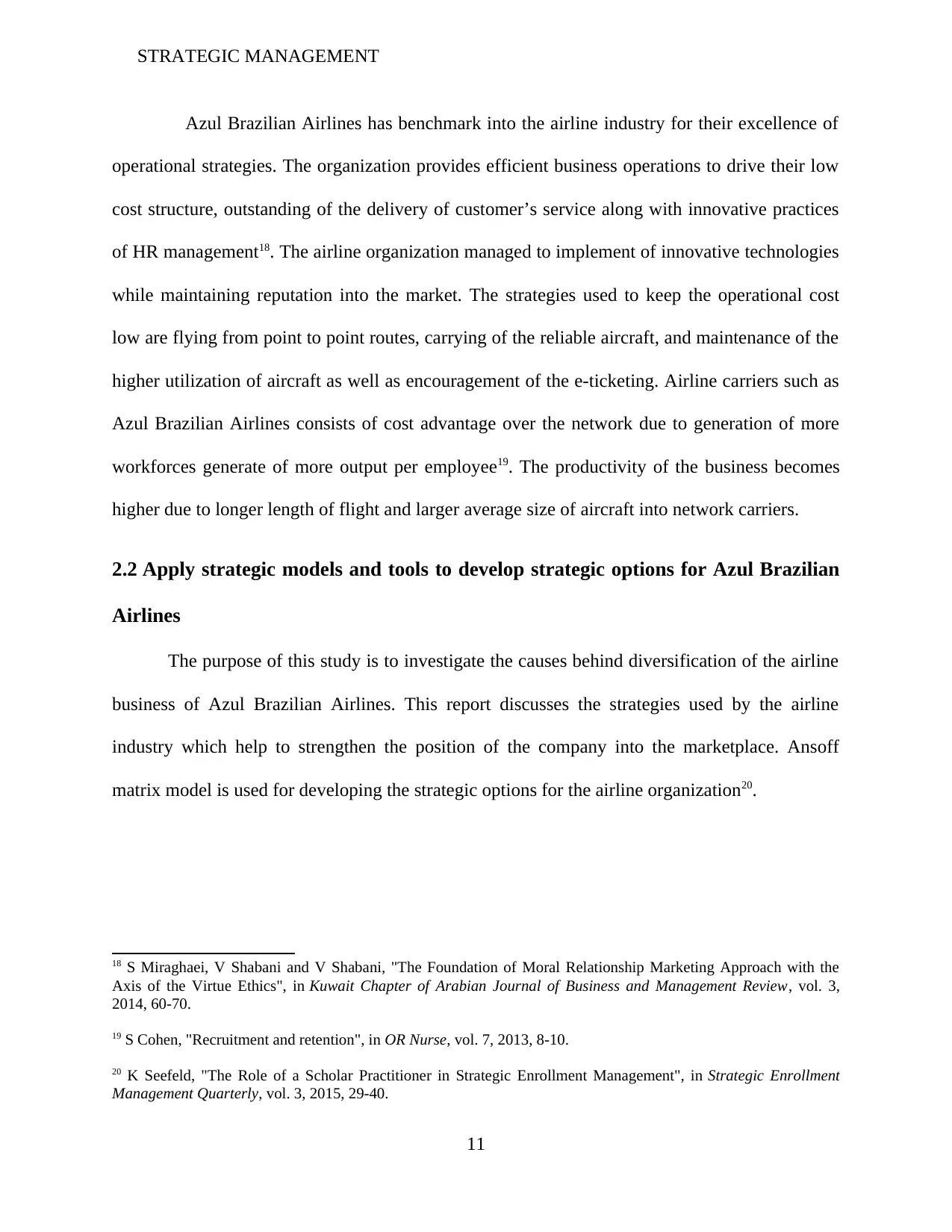
STRATEGIC MANAGEMENT
Azul Brazilian Airlines has benchmark into the airline industry for their excellence of
operational strategies. The organization provides efficient business operations to drive their low
cost structure, outstanding of the delivery of customer’s service along with innovative practices
of HR management18. The airline organization managed to implement of innovative technologies
while maintaining reputation into the market. The strategies used to keep the operational cost
low are flying from point to point routes, carrying of the reliable aircraft, and maintenance of the
higher utilization of aircraft as well as encouragement of the e-ticketing. Airline carriers such as
Azul Brazilian Airlines consists of cost advantage over the network due to generation of more
workforces generate of more output per employee19. The productivity of the business becomes
higher due to longer length of flight and larger average size of aircraft into network carriers.
2.2 Apply strategic models and tools to develop strategic options for Azul Brazilian
Airlines
The purpose of this study is to investigate the causes behind diversification of the airline
business of Azul Brazilian Airlines. This report discusses the strategies used by the airline
industry which help to strengthen the position of the company into the marketplace. Ansoff
matrix model is used for developing the strategic options for the airline organization20.
18 S Miraghaei, V Shabani and V Shabani, "The Foundation of Moral Relationship Marketing Approach with the
Axis of the Virtue Ethics", in Kuwait Chapter of Arabian Journal of Business and Management Review, vol. 3,
2014, 60-70.
19 S Cohen, "Recruitment and retention", in OR Nurse, vol. 7, 2013, 8-10.
20 K Seefeld, "The Role of a Scholar Practitioner in Strategic Enrollment Management", in Strategic Enrollment
Management Quarterly, vol. 3, 2015, 29-40.
11
Azul Brazilian Airlines has benchmark into the airline industry for their excellence of
operational strategies. The organization provides efficient business operations to drive their low
cost structure, outstanding of the delivery of customer’s service along with innovative practices
of HR management18. The airline organization managed to implement of innovative technologies
while maintaining reputation into the market. The strategies used to keep the operational cost
low are flying from point to point routes, carrying of the reliable aircraft, and maintenance of the
higher utilization of aircraft as well as encouragement of the e-ticketing. Airline carriers such as
Azul Brazilian Airlines consists of cost advantage over the network due to generation of more
workforces generate of more output per employee19. The productivity of the business becomes
higher due to longer length of flight and larger average size of aircraft into network carriers.
2.2 Apply strategic models and tools to develop strategic options for Azul Brazilian
Airlines
The purpose of this study is to investigate the causes behind diversification of the airline
business of Azul Brazilian Airlines. This report discusses the strategies used by the airline
industry which help to strengthen the position of the company into the marketplace. Ansoff
matrix model is used for developing the strategic options for the airline organization20.
18 S Miraghaei, V Shabani and V Shabani, "The Foundation of Moral Relationship Marketing Approach with the
Axis of the Virtue Ethics", in Kuwait Chapter of Arabian Journal of Business and Management Review, vol. 3,
2014, 60-70.
19 S Cohen, "Recruitment and retention", in OR Nurse, vol. 7, 2013, 8-10.
20 K Seefeld, "The Role of a Scholar Practitioner in Strategic Enrollment Management", in Strategic Enrollment
Management Quarterly, vol. 3, 2015, 29-40.
11
⊘ This is a preview!⊘
Do you want full access?
Subscribe today to unlock all pages.

Trusted by 1+ million students worldwide
1 out of 33
Related Documents
Your All-in-One AI-Powered Toolkit for Academic Success.
+13062052269
info@desklib.com
Available 24*7 on WhatsApp / Email
![[object Object]](/_next/static/media/star-bottom.7253800d.svg)
Unlock your academic potential
Copyright © 2020–2025 A2Z Services. All Rights Reserved. Developed and managed by ZUCOL.





